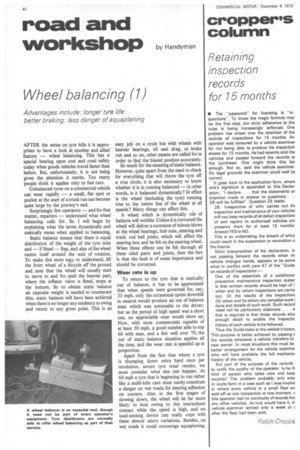road and
Page 42

If you've noticed an error in this article please click here to report it so we can fix it.
workshop by Handyman
Wheel balancing (1)
Advantages include: longer tyre life: better braking: less danger of aquaplaning
AFTER the series on tyre bills it is appropriate to have a look at another and allied feature — wheel balancing. This has a special bearing upon cost and road safety today when goods vehicles travel faster than before. But, unfortunately, it is not being given the attention it merits. Too many people think it applies only to fast cars.
Unbalanced tyres on a commercial vehicle can wear rapidly — a small, fiat spot or pocket at the start of a trunk run can become quite large by the journey's end.
Surprisingly few operators — and for that matter, repairers — understand what wheel balancing calls for. So I will begin by explaining what the terms dynamically and statically mean when applied to balancing.
Static balance means that there is equal distribution of the weight of the tyre tube and — if fitted — flap, and also of the wheel centre itself around the axis of rotation. To make this more eapy to understand, lift the front wheel of a bicycle off the ground and note that the wheel will usually start to move to and fro until the heavier part, where the inflator valve is fitted, stops at the bottom. So to obtain static balance an opposite weight is needed to counteract this; static balance will have been achieved when there is no longer any tendency to swing and return to any given point. This is an easy job on a cycle but with wheels with heavier bearings, oil seal drag, or brake rub and so on, other means are called for in order to find the biased position accurately.
So much for the meaning of static balance. However, quite apart from the need to check for everything that will throw the tyre off a true circle, it is also necessary to know whether it is in running balanced — in other words, is it balanced dynamically? In effect is the wheel (including the tyre) running true to the centre line of the wheel at all speeds? Many things can affect this.
A wheel which is dynamically out of balance will wobble. Unless it is corrected the wheel will deliver a sucession of minute blows at the wheel bearings, hub nuts, steering and track rod ball joints, which will affect the steering box and be felt on the steering wheel. When these effects can be felt through all these oiled parts and joints, then the fact is that the fault is of some importance and should be corrected.
Wear rate is up
To return to the tyre that is statically out of balance, it has to be appreciated that when speeds were governed for, say, 33 mph, only the occasional sprint downhill in neutral would produce an out of balance state which was noticeable to the driver; but as the period of high speed was a short one, no appreciable wear would show up. Now, with most commercials capable of at least 50 mph, a good number able to top 60 with ease, and a few well over 70, the out of static balance situation applies all the time, and the wear rate is speeded up in proportion.
Apart from the fact that where a tyre is thumping down extra hard once per revolution, severe tyre wear results, we must consider what else can happen. At 60 mph a tyre that is beginning to run rather like a multi-lobe cam must surely constitute a danger on wet roads for steering adhesion on corners. Also in the first stages of slowing down, the wheel will be far more likely to lock owing to this intermittent contact while the speed is high, and no load-sensing device can really cope with these almost micro variations. Besides, on wet roads it could encourage aquaplaning.








































































































